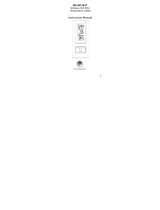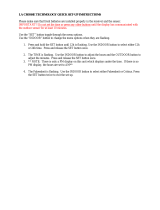
6
walls, floors, ceilings, thick trees, etc.) will
effectively cut signal range in half.
Example: A wireless weather station with a
330 feet range is mounted on an interior wall,
so that the signal has to pass through one
interior wall, one exterior wall, and across the
10 feet width of the room between the 2 walls.
The first wall will reduce the range to 165 feet,
and the second wall will reduce the range to
87 feet. Factoring in the 10 foot room, this
leaves a maximum of 77 feet of remaining
signal range.
This allowance is typically enough for a frame
wall with non-metallic siding; however certain
materials can reduce range even further.
Metal siding, stucco, and some types of glass
can reduce signal range by as much as ¾ or
more, compared to the ½ reduction typical of
most obstructions. It is possible to receive a
signal through these materials, however
maximum range will be much less due to their
tendency to absorb or reflect a much larger
portion of the sensor’s signal.



























